Although I love photography, I don’t think I’d profess to be a wonderful photographer. But over the last few years, travelling through a multitude of countries and exhausting at least three different point and shoot cameras, I’ve learned some techniques through trial and error that have really helped my travel photography.
What makes a good travel photographer?
The four main photographic points I try to cover on any trip are colour, scenery, atmosphere and people. The methods of achieving these are simple; pay attention to your surroundings, get off the beaten path and explore as much as you can. Whether it involves wandering through a city’s back streets or sorting out a hire car
and driving huge distances in search of subject matter, every country has a wealth of photographic material just waiting to be captured on film.
It’s rare these days to see a tourist without some kind of camera in their hand. The rise in mobile photography has made it incredibly easy to record your travels – but it also means there’s a bank of eager amateurs ready to capture all the same moments as you.\
All those infamous landmarks you’re visiting around the world are so over-photographed that it almost feels like cheating to take the same generic Google image – which is when thinking outside the box
really helps.
How to capture a great travel photograph
Get up close to your subjects, especially if they’re food, static objects, buildings, and architecture. Look for details, instead of attempting to capture an entire scene within the frame. Go for crazy angles, and shoot higher into the sky and lower into the ground to catch some unprecedented content at different perspectives.
Those photo-happy tourists also make my life much easier, as I’m constantly learning from them. Whatever they’re taking copious photos of, I immediately look the other way and search for something totally different to shoot – often the unseen shot turns out to be the best.
Any photo that tells a story is bound to captivate an audience. And when you’re travelling, stories are the most memorable aspect of a trip – for me at least. I make sure to look for locations filled with potential stories. Local markets, parades, festivals
and sporting events are all primed for unique photo opportunities filled with stories – and try turning the camera on your fellow observers, too.
Why you should take photos when you travel
As a rather self-conscious traveller, I often wrestle with my conscience about taking photos of local people in the places I travel to. It’s a common feeling that once you break the easy observational relationship with a local by chucking a camera lens into the mix, you become little more than a cheap tourist, while they are reduced to an object of interest. It’s also important to ensure the specific culture you’re photographing is happy for their image to be captured; often the older generation – and cultures favouring privacy – don’t appreciate unwanted attention.
Knowing that I may have turned the situation sour is embarrassing, but it has to be said that there’s nothing like those spontaneous shots of everyday moments that no one else has seen. The times I’ve shied away from putting a camera in someone’s face are also often the times when I’ve regretted the shot I missed.
In which case, always asking permission for a photograph from your subject is imperative – or if you don’t know the local language, showing the digital shot to your subject afterwards is a good way to gain approval.
Travelling or photography?
Keeping a happy equilibrium between photography and travelling is important: people often hypothesise that by taking photos you’re missing out on the experience itself. While this is certainly true, I find that photography while travelling is the best way both to learn more about the country you’re visiting, as well as keeping your memories fresh.
Searching out exciting subjects and telling stories through film will give your travels another layer of interest – which, in my opinion, can only enrich a travelling experience.


